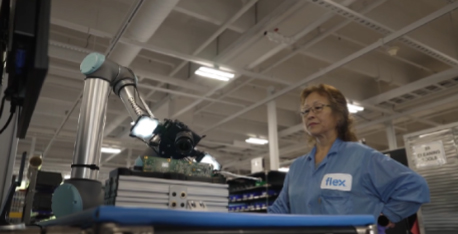Automated systems with AI/ML capabilities streamline inspections, increase productivity and save costs for manufacturers, benefiting workers.
By Murad Kurwa, Vice President of Advanced Manufacturing Engineering, Flex
As manufacturers increase factory speed and efficiency with advanced, automated technologies, product inspections should not be overlooked.
After all, increasing speed along certain portions of the production line can be self-defeating if it causes bottlenecks at another section.
The introduction of automation, robotics and other advanced manufacturing technologies has enabled organizations to keep pace with growing product complexities and greatly accelerate production speeds, but also pose a challenge to workers performing visual quality inspections. It’s not only the speed that inspectors deal with when examining products as they come down the line. They need to carefully inspect a wide range of vital components, including screws, wires and labels. After hours of inspecting products according to precise criteria, visual fatigue can set in and potentially lead to mistakes.
Vision detection and inspection systems using artificial intelligence (AI) and machine learning (ML) can help solve both problems, streamlining operations on the production line while increasing accuracy and minimizing errors.
As we discovered after implementing AI/ML inspection processes at multiple Flex sites, the AI/ML detection and inspection systems significantly reduced inspection times while increasing efficiency and improving quality. On top of that, the systems also produced cost savings by reducing scrap before a part was sent ahead to the next step in the production line.

In two different scenarios, Flex developed purpose-built options for AI/ML-based detection and inspection to improve quality inspections on the factory floor, each with neural networks trained to identify defects, including those that can be beyond the ability of human inspectors or conventional vision systems to find. And because the AI/ML models are learning systems, their performance improves over time.
Before a system is deployed, engineers use photos of the product and production process to train the models on the systems they will be analyzing. Teams then test the models and evaluate the results to ensure that these models are not making false calls or errors based on insufficient data or training.
When the system’s capabilities have been programmed and tests have engendered a high level of confidence, the system can be leveraged for use in addressing key error groups, such as anomaly detection, image classification, segmentation and object detection.
Once deployed on the shop floor, the systems have quickly delivered positive results. At a Flex site where a system inspected hardware production, for example, efficiency jumped by 30%+ and product yield increased by 97%. At another location producing sheet metal components, efficiency increased by 28% and the customer saw a triple-digit return on investment.
Not least among the benefits that AI/ML inspection systems deliver is the impact it has on the employees, who, automation notwithstanding, remain integral to factory operations. An AI/ML system creates opportunities for product inspectors to learn how to manage the new technology, which will give them new skills that can help their careers. And, rather than repetitively performing painstaking inspections, staff members can work on the strategic aspects of manufacturing, which can boost their morale while building out new skillsets.
The success of Flex’s implementations has led to further use of automated inspection technologies, and the lessons learned can help guide companies that are planning to expand the use of AI/ML systems on their shop floors.
AI has been a lightning rod for debate in recent years. Even with the undeniable benefits AI offers in speed, efficiency, and productivity, these benefits have all been counterbalanced by concerns of job loss and unethical use of the technology.
However, as technology continues to evolve and take shape in other fields, both AI and ML are already finding their place in manufacturing by providing practical optimizations that can significantly streamline production. The ability of these systems to enhance production by increasing the speed and precision of quality inspections is just one example.
The transition to greater automation in manufacturing is well underway, and companies that fail to take advantage of these technologies risk being left behind. As Flex has found with its implementations, AI/ML systems not only increase efficiency and reduce costs, but also create new career opportunities for workers.
AI and ML are now solidly positioned at the forefront of Industry 4.0 efforts to transform manufacturing operations. Adding advanced inspection tools to the production line is part of that evolution, providing a very effective way to improve results and increase productivity across the entire enterprise.

About the Author:
Murad Kurwa is Vice President of the Advanced Manufacturing Engineering Group at Flex, the manufacturing partner of choice that helps a diverse customer base design and build products to improve the world.
Bringing 40 years of industry experience in the electronics, semiconductor and material sciences fields, Mr. Kurwa has spent the last 25 years in leadership roles in Operations, Engineering, and Product Development. In his current role, he is responsible for the company’s global advanced manufacturing engineering across ~100 facilities in 30 countries. He oversees assembly and test technology, automation and robotics, Industrial Internet of Things, AI, and Machine Learning strategy, applications, and deployment to continuously optimize production processes and drive efficiencies.
He holds a master’s degree in business administration and a bachelor’s degree in chemical engineering and has been published in over 20 industry and scholarly journals. He co-owns 15 patents in the field of automation, wearables, material science, and IIoT.
Scott Ellyson, CEO of East West Manufacturing, brings decades of global manufacturing and supply chain leadership to the conversation. In this episode, he shares practical insights on scaling operations, navigating complexity, and building resilient manufacturing networks in an increasingly connected world.